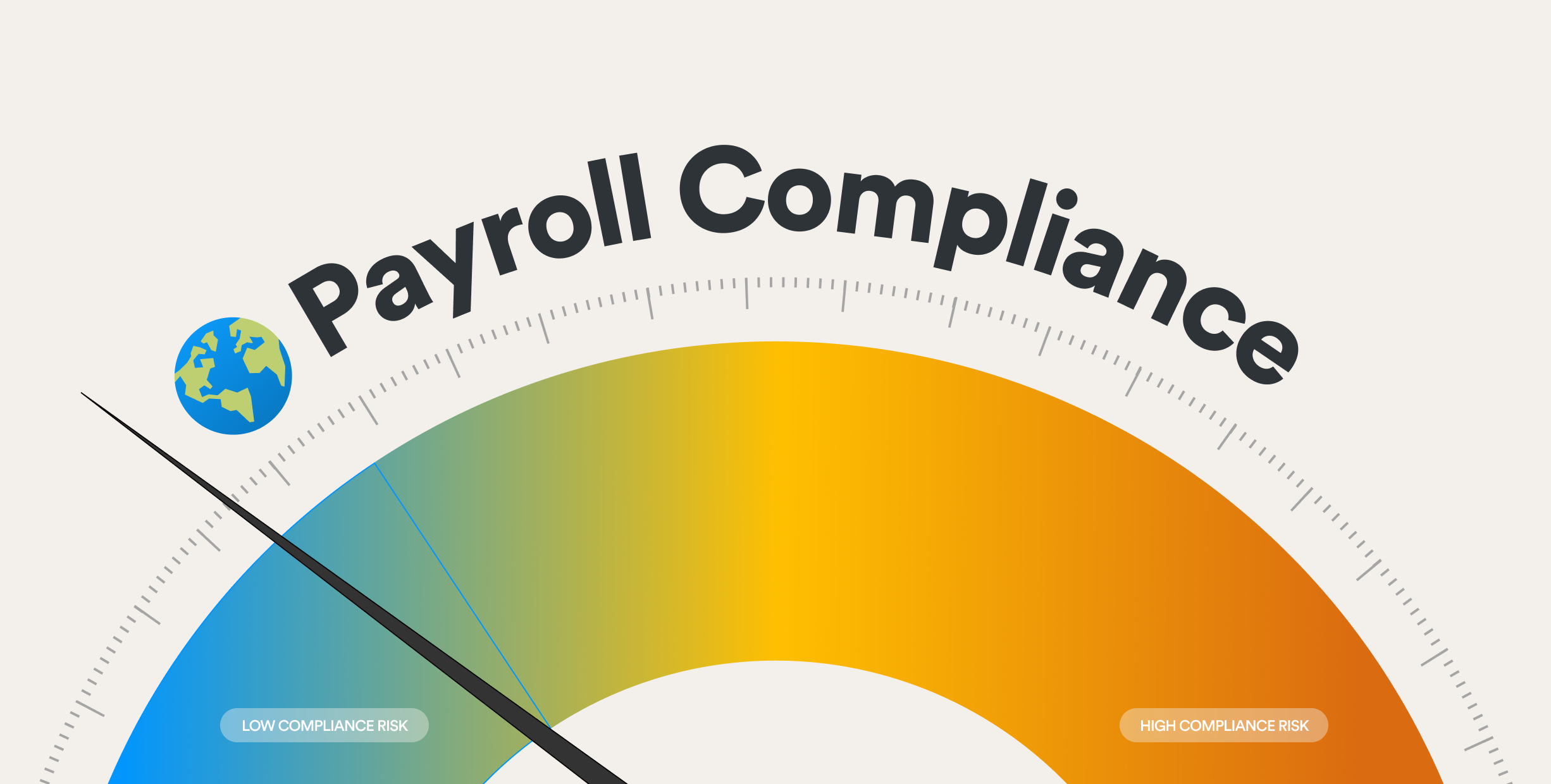Global Payroll Compliance 101
A practical framework to stay compliant across borders — without drowning in admin.

Summary: Global payroll compliance means paying every worker, in every country, according to local tax, labor, benefits, and reporting rules. This guide gives founders and HR leaders a practical framework: classify workers correctly; localize tax withholding and filings; meet statutory and expected benefits; ensure compliant cross-border payments; safeguard employee data; maintain audit-ready records; and embrace automation. It explains why compliance matters from day one for distributed teams and outlines the risks of misclassification, missed deadlines, and fragmented systems. Finally, it shows how a self-driving payroll model turns compliance into background infrastructure with automated updates, exception handling, and one system for employees and contractors, so small teams can scale confidently, anywhere.When you’re hiring globally, global payroll compliance means making sure every employee in every country is paid in line with local tax laws, benefits requirements, and reporting rules.For a founder or HR leader, the stakes couldn’t be higher. Getting compliance wrong can mean fines, legal action, reputational damage, and more. But getting it right has historically been a heavy administrative lift — one that small teams rarely have the capacity to handle.This walkthrough is designed to break compliance into clear, manageable components. Whether you’re a founder scaling quickly or a People leader at a growth-stage company, it lays out what you need to know — and how a self-driving payroll model makes it possible to stay compliant without drowning in admin.
Why compliance matters more than ever
Global workforces are no longer the exception. Even two-person startups hire their first engineer in Buenos Aires, their first designer in Berlin, or their first customer support rep in Manila. That means payroll compliance is a global issue from day one.The risks of ignoring it:- Legal exposure: Misclassification or missed filings can bring lawsuits and penalties. Misclassification lawsuits are costly in terms of both legal fees and settlements, which can be in the millions of dollars. In 2016, FedEx paid $240 million to settle misclassification class-action lawsuits, while in 2025, logistics provider NFI agreed to pay $5.75 million to drivers to settle a decade-long suit.
- Financial risk: Late or inaccurate tax submissions often lead to heavy fines. For example, in the US, a delayed federal employment tax deposit means paying a 2 percent penalty, with the penalty amount increasing up to 15%, depending on the length of the delay.
- Reputation risk: A delayed paycheck in one country can damage employer brand everywhere and decrease worker morale.
Two perspectives
- For founders: Compliance isn’t the reason you started a company. It’s overhead. You want it off your plate as fast as possible so you can focus on product and growth.
- For HR leaders: Compliance is the risk you’re personally accountable for. You can’t afford errors, but you also don’t have the bandwidth to juggle the complexity of managing compliance in 50+ countries.
Global payroll compliance: A framework
Below is the framework every company needs to cover. Each category represents a key compliance area. Together, they form the backbone of a scalable, repeatable payroll compliance process.1. Classify workers correctly
The first compliance step is ensuring that every worker is correctly classified. Employees, contractors, and gig workers are governed by different laws. Misclassification is one of the most common (and costly) mistakes global companies make.- Verify employment type: Is this worker truly a contractor, or are they functioning like an employee? How to classify one vs. the other will vary by country. For the classification of US workers, check out our overview in our guide.
- Country-specific rules: As mentioned above, each jurisdiction defines classification differently. In some countries, a worker who may be classified as an “employee” in the US may classify as a contractor, or vice versa. Be sure to understand the specifics of the classification laws for every country where you’re hiring and to use localized contracts for each worker type.
- Document everything: Keep signed contracts and classification assessments on file.yee beyond 18 months, there are a few possible paths.
2. Localize tax withholding and filings
Every country has its own rules on how much tax must be withheld, when payments are due, and how reporting must be filed.- Localized tax calculations: Make sure you’re working with an experienced global payroll provider or accountant who knows what taxes apply for every country and jurisdiction where you’re hiring. Ideally, use a payroll system that automates these calculations.
- Track filing deadlines: Some countries require monthly submissions, others quarterly or annually.
- Handle dual obligations: In the US, employers must file both employee and employer taxes. Many countries have similar two-sided rules.
3. Understand mandatory and expected benefits and entitlements
Global compliance doesn’t end with taxes. Employees are entitled to benefits, and those benefits vary dramatically across regions. Locally, you may also find that meeting the minimum requirements for benefits and entitlements is not enough; local employees and contractors may expect additional benefits that are considered the norm. For instance, in Pakistan, companies are not legally required to provide health insurance to their employees, but many companies do.- Paid leave entitlements: Parental leave, sick leave, and vacation days are often statutory.
- Mandatory benefits: Health insurance, retirement contributions, and social security equivalents differ by country.
4. Ensure compliance with cross-border payments
Paying people globally isn’t just a banking challenge; it can be a compliance challenge, too- Payment timing: In some regions, wages must be paid by a certain day each month without exception.
- Banking rules: IBAN, SWIFT, and local clearing systems all have their quirks.
5. Safeguard employee data and privacy
Payroll data is highly sensitive. Mishandling it can lead to GDPR violations in Europe or breaches of local privacy laws elsewhere.- Secure storage: All personal data (names, addresses, bank details) must be stored in compliance with local privacy rules.
- Consent management: Some countries require explicit employee consent for certain data uses.
6. Maintain detailed records and audit trails
Compliance isn’t just about doing the right thing — it’s about proving you did.- Retention periods: Different countries mandate how long payroll records must be kept (e.g., under the Fair Labor Standards Act, US companies must keep records for at least 3 years).
- Consistent documentation: Pay stubs, tax filings, benefit contributions, and classification documents must be accessible.
- Digital-first: Paper processes make global audits much more difficult.
7. Embrace automation
The single biggest shift in payroll compliance comes from automation. The old model required constant manual oversight; the new model allows systems to self-drive compliance tasks.- Automated updates: Changes in laws and tax rates should be automatically reflected in your payroll and HR platform. For example, if a new employment law affects your employees, you should automatically get notified that a new employment contract is ready.
- Exception handling: When a payment fails or a rule changes, the system should attempt to fix it before escalating.
- One platform for everyone: Instead of juggling separate payroll and HR platforms for contractors and employees, you should be able to pay them all automatically from one place.
Common compliance mistakes companies make
Even well-intentioned teams stumble. The most common pitfalls include:- Misclassifying contractors as employees (or vice versa).
- Missing filing deadlines due to time zone differences.
- Overlooking mandatory local benefits.
- Using multiple vendors and creating fragmented records.
How Plane helps companies stay compliant
Plane was built from the ground up on a different philosophy: software should think like you think and work in the background for you, so you can focus on growing your company.That means compliance becomes infrastructure, not overhead.- Unified: Employees and contractors, US and international, all managed under one system.
- Deconstructed: You define outcomes (“give Sarah a raise”); the system handles calculations, taxes, filings.
- Global: Compliance is built-in across borders, so you don’t have to be a compliance expert for every country where you’re hiring employees and/or contractors.
- Self-driving: The system proactively solves problems before they reach you.
- Empowering: Small teams get the same compliance muscle that once required hundreds of people.
Founders vs. people leaders: Specific guidance
For founders and entrepreneurs
- Invest in the right infrastructure: Don’t try to become an employment and tax law expert in every country where you want to hire. Invest in infrastructure that handles compliance end-to-end, automatically.
- Prioritize compliance: Compliance is essential. Make sure the payroll provider you’re working with is knowledgeable and globally compliant.
- Scale with confidence: Work with a provider that enables you to easily hire anyone, anywhere, without worrying about getting burned later.
For heads of people / HR leaders
- Mitigate risk: Compliance failures land on your desk. Work with a payroll platform that automates compliance.
- Be audit-ready: Maintain secure, digital records and apply country-specific record retention rules.
- Deliver experience: Work with a global payroll provider that ensures employees and contractors get paid on time, every time, without your having to troubleshoot payment issues.
Conclusion: Compliance as infrastructure
Payroll compliance isn’t optional, but it shouldn’t be a burden. With the right systems in place, compliance becomes background infrastructure: always on, always accurate, and always adapting.A global payroll compliance framework is the starting point. But the future is self-driving payroll — where compliance runs itself and small teams operate with the leverage of giants.Plane isn’t just another payroll tool. It’s the infrastructure that makes global compliance effortless, so founders can build and HR leaders can scale without fear.FAQs
What is global payroll compliance?
Global payroll compliance means ensuring employees across different countries are paid according to all relevant local tax, labor, and reporting regulations.Why is global payroll compliance important?
It helps prevent legal penalties, audit failures, reputational damage, and employee dissatisfaction. It also ensures companies can scale with confidence internationally.How can I stay compliant when paying workers in multiple countries?
Work with a global payroll platform that handles country-specific taxes, benefits, classification logic, and reporting requirements.What penalties can I face for non-compliance?
Penalties range from monetary fines and delayed tax filings to lawsuits, class actions, and blocked hiring rights in certain regions.How often do payroll laws change?
Payroll laws can change as frequently as quarterly, or even more often. Countries regularly update tax brackets, benefits mandates, and filing procedures.Does worker classification affect payroll compliance?
Yes. Misclassifying employees as contractors (or vice versa) can lead to fines, back pay, and audits. Classification rules differ significantly by region, so it’s essential to work with a knowledgeable employment partner.Related articles
From startups to beyond, US companies of all sizes use Plane for global payroll, benefits and compliance.
How Plane Helps You Stay Compliant in 240+ Countries
A closer look at the laws, systems, and real-world workflows that make global hiring simpler — and safer.
What You Need to Know About Paying Contractors in Brazil
A practical guide to hiring, paying, and staying compliant when working with freelancers and independent professionals in Brazil.
Before You Hire, Check Twice: Introducing Plane’s Worker Classification Tool
Our new tool helps you prevent frightful fines and compliance nightmares.
